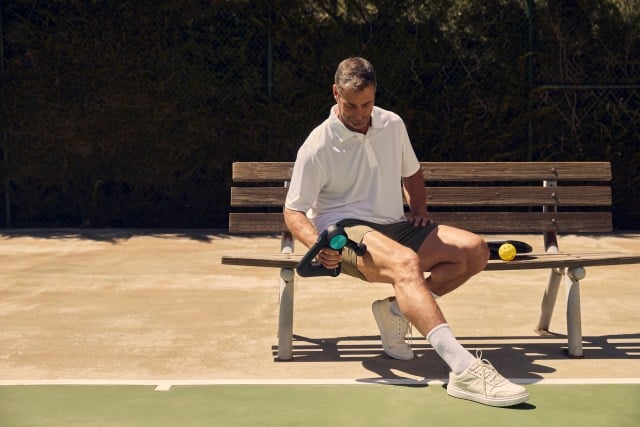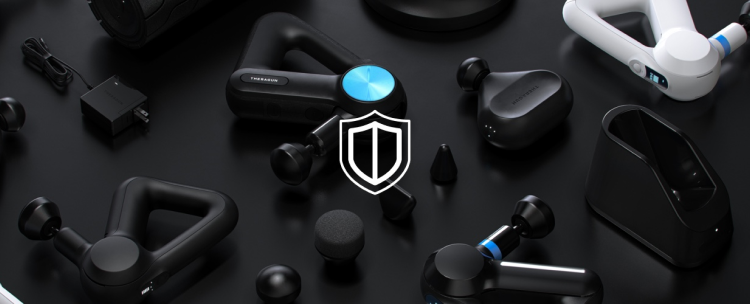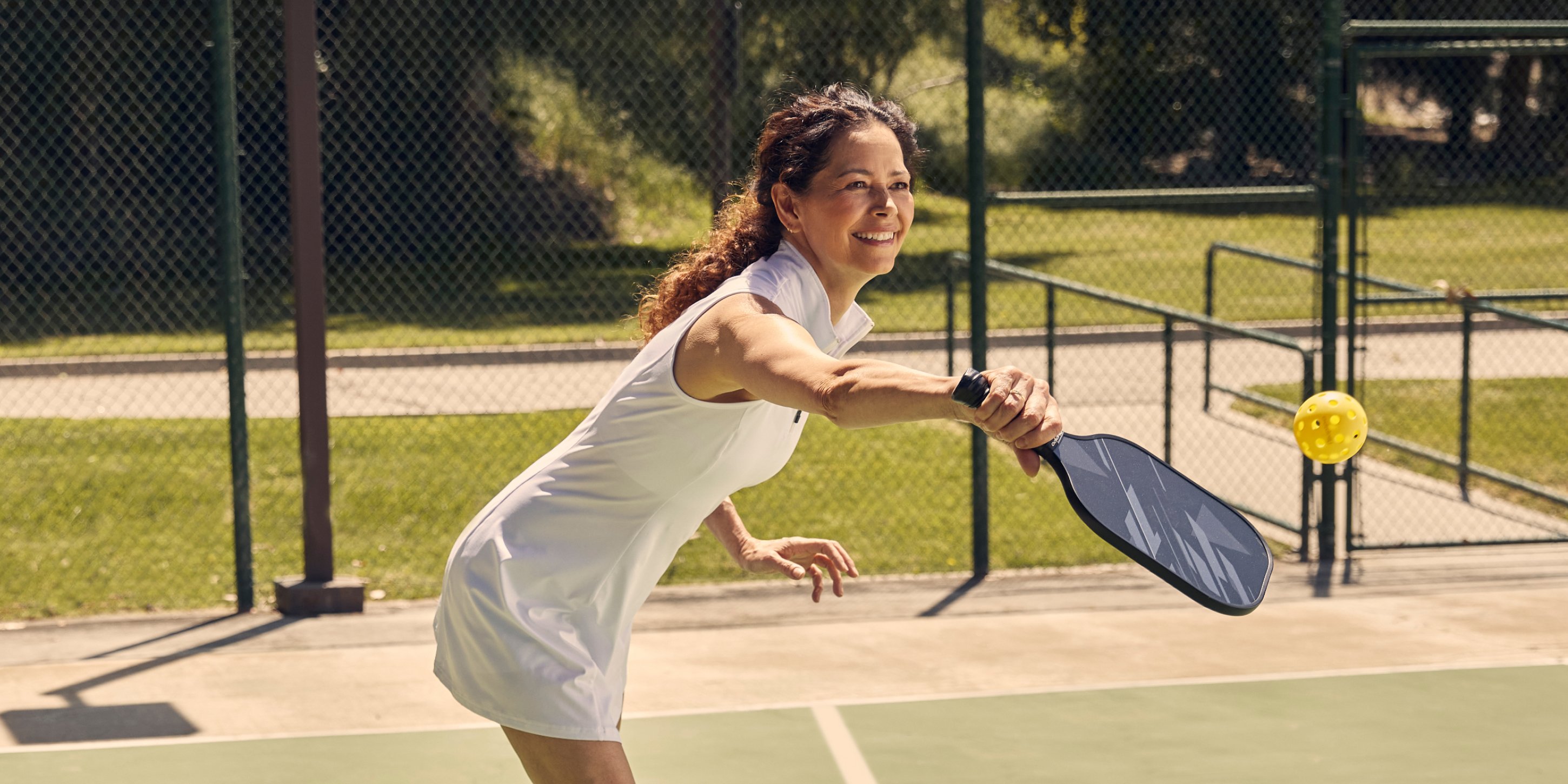Authors: Therabody Scientists: Tim Roberts, MSc; Kyle Silvey, PhD, CSCS; Michelle Darian, MS, MPH, RD, LDN
Pickleball is quickly becoming America’s new favorite pastime. This quirky cross between tennis, ping pong, and badminton is bringing a new level of activity back into (or for the first time to) many people’s lives.
The sport pitches itself as an accessible activity. Courts are popping up everywhere, equipment costs are relatively low, and it’s quicker to learn and less strenuous than other sports like tennis. While pickleball may be more accessible than other sports, a 2020 study published in the Journal of Emergency Medicine estimates that there are around 19,000 pickleball injuries each year in the U.S., with 90% of those cases affecting folks 50 years and older. [1]
So, if you’re on the pickleball bandwagon, here’s what you need to know about sport-related injuries and what you can do to reduce their likelihood.
Why is Pickleball Causing More Injuries?
Many pickleball injuries boil down to a few key concerns. The first one is poor conditioning. In sports medicine, conditioning is the process of preparing your body for a given activity by engaging the muscle groups, energy systems, and patterns of movement that are relevant to the sport. [2]
During pickleball, you lunge side-to-side to reach the ball and constantly change directions at high speeds. So, if you’re accustomed to exercises like running or weight training, you may be more used to doing an activity in a single direction or position.
So, when you hit the pickleball court and move your body in a new way, your muscles, tissues, and joints may give up quickly. This is only compounded if you go all into the sport without a proper warm-up or recovery, which is common as pickleball is as competitive as it is social.
Age can also play a factor. It’s estimated that about 75% of regular pickleball players are 55 years or older. [3] And your agility at 55 may not be what it was when you were 20 (even if you feel like it is). While your brain may signal you to sprint or shuffle, your body may scream in protest.
What Are Common Pickleball Injuries?
Common pickleball injuries can look like sprains and strains in the lower body (like ankle, knee, hamstring, hip, and Achilles tendon) and upper body (rotator cuff, neck, and wrist). Bending over and twisting the upper body during shots can contribute to strains or discomfort in the lower or upper back. [3]
And, of course, falls from quickly pivoting for a ball can lead to a variety of injuries.
How To Help Prevent Pickleball Injuries
Besides slowly entering the world of pickleball (like practicing once a week for an hour versus starting at four days a week for three plus hours), proper warm-up and recovery routines can help to reduce your risk of injuries.
How To Warm –Up Before Pickleball
The goal of a warm-up is to improve your range of motion, increase blood flow, increase the temperature of tissues (making them more fluid), and prime the muscles for the movement they’re about to encounter. [5]
Research shows that warming up is an effective way to reduce the risk of injury. [6] So, make sure to always take about 10 minutes to prime your body for the game ahead.
Because pickleball is a full-body sport, it’s important to program a warm-up and recovery that cover muscle groups throughout the body. Josh Adams, MS, CSCS, created warm-up and recovery routines for both beginner and advanced pickleball players:
Beginner Warm-Up
- Forward jog (the length of the court).
- Backward jog (the length of the court).
- Knee hugs (five on each side): Standing with feet together, bring one knee up toward the chest, grabbing the knee with both hands to pull it higher. Finish by standing tall.
- Wide hamstring stretch (five on each side): Stand with feet wider than shoulder-width apart. Keep the legs straight, bend at the waist, and reach the right hand toward the left foot. Return to standing position, then repeat the movement on the other side, reaching the left hand toward the right foot.
- High knee march (15 seconds).
- Lateral shuffle (10 yards in each direction).
Advanced Warm-Up
- Forward skip with forward arm swing (the length of the court).
- Backward skip with backward arm swing (the length of the court).
- Lateral shuffle with arm swing (half the length of the court each way).
- Forward lunge with rotation (five times on each side): Lunge forward with the right leg, keeping the back knee just above the ground at the bottom of the lunge. When you reach the bottom of the lunge, rotate your upper body to the right.
- Hamstring scoops (8 times on each side): Standing tall, reach your right leg slightly out in front of you with your heel on the ground. Pull your toes up toward the ski, away from the ground. While keeping both legs straight, bend at the waist while keeping your back straight. Make a “scooping motion with your arms toward the right ankle. You should feel a noticeable stretch in the right hamstring. Return to a standing position and repeat on the left side.
- Single leg drop, (3 times on each side): Standing tall with both feet together, reach overhead with the arms and raise up onto the ball of each foot. Quickly drop into an athletic position, landing on ONLY your right leg. Hold your balance on your right leg for 2 seconds. Return to the top position and repeat, landing on the left leg.
- Start standing (3 times): Starting standing tall with your arms overhead, quickly drop into a low athletic position with your knees and hips bent. When you land, move your feet up and down FAST in a running motion for five seconds while only bringing your feet off the ground a couple of inches. Return to standing position and repeat 2 more times.

How To Recover After Pickleball
After your bout of pickleball for the day, a proper recovery can also help to prevent injuries — as fatigued muscles and joints are more injury-prone. It can also help prevent overuse injuries like tendonitis or stress fractions.
So, instead of heading home right away or out to eat your pickleball friends, set aside another 10 minutes or so to stretch.
Beginner Recovery
- Shoulder stretch (30 seconds on each side): Bring your right arm across your chest, gently pulling it with your left hand. Switch sides.
- Quad stretch (30 seconds on each side): Stand on one leg and bring the heel of your other leg toward your bottom, holding your ankle with your hand. Complete on both legs.
- Calf stretch (30 seconds on each side): Stand facing a wall, place one foot behind you, and lean forward, keeping the back leg straight. Switch legs.
- Side stretch (30 seconds on each side): Plant your feet on the ground and bring your right arm overhead, keep your left hand on your hip, and bring your right hand towards the left side of your body. Switch sides.
Advanced Recovery
- Shoulder stretch (30 seconds on each side): Bring your right arm across your chest, gently pulling it with your left hand. Switch sides.
- Quad stretch (30 seconds on each side): Stand on one leg and bring the heel of your other leg toward your bottom, holding your ankle with your hand. Complete on both legs.
- Calf stretch (30 seconds on each side): Stand facing a wall, place one foot behind you, and lean forward, keeping the back leg straight. Switch legs.
- Side stretch (30 seconds on each side): Plant your feet on the ground and bring your right arm overhead, keep your left hand on your hip, and bring your right hand towards the left side of your body. Switch sides.
- 3-way hamstring stretch: Sitting on the ground, with legs spread, reaching toward the right leg with both hands for 30 seconds, then the left leg for 30 seconds, then toward the middle for 30 seconds.
- Figure 4 stretch (30 seconds on each side): Lie on the ground face up and cross your right leg over your left leg, allowing the right knee to fall to the side, away from the left leg. Grab the left leg with both hands, pulling the knee toward your chest. You should feel a noticeable stretch on the outside of the right hip. You can adjust the intensity of the stretch by how far you pull the left leg into your chest. Repeat on each side.
- Wrist stretch (60 seconds on each side): Reach both hands out in front of you with your elbow straight and use your left hand to push your right hand down toward the ground. Hold for 30 seconds. Then, with your right palm facing away from you, use your left hand to pull your hand back toward you, bending at the wrist. Hold for 30 seconds, repeat on the other side.
You can also use a Theragun to help you recover. The percussive therapy delivered by these massage guns helps increase blood flow (vital for optimal muscle recovery), reduce muscle tightness and pain, and support muscle strength, flexibility, and power when used after a workout. [7]
When you connect your Theragun device to the Therabody app, you gain access to hundreds of expert-crafted routines — including one designed to support pickleball recovery. It guides you through exactly where to place the massage gun (and for how long) to target the key muscle groups used in the sport: calves, quadriceps, glutes, lower back, upper back, chest, and so on. (There’s also a guided routine for a pickleball warm-up).
All Theraguns are compact enough to easily fit in most gym bags, so you can always bring them with you. If you’re on and off the court for hours, you can also use it between matches to give your muscles additional reprieve and keep you excelling on the court for longer.
Key Takeaways:
- Pickleball is growing in popularity and is bringing a new level of activity to people’s lives (especially those 55+).
- While pickleball is an accessible sport for most, it’s still a sport. And ramping up your play and intensity too quickly can lead to injury.
- Through intentional warm-ups and proper recoveries, you may have the potential to reduce your risk of developing an injury that will surely keep you off the court.
- As a warm-up, consider adding dynamic stretches to your pre-game routine, as well as some lateral cardio movements.
- For your recovery, try some static stretching and make sure you reach for your Theragun for the added support of percussive therapy.
References
- https://pubmed.ncbi.nlm.nih.gov/31796221/
- https://pubmed.ncbi.nlm.nih.gov/31465458/
- https://www.ncbi.nlm.nih.gov/pmc/articles/PMC6913863/
- https://www.ncbi.nlm.nih.gov/pmc/articles/PMC6913863/
- https://pubmed.ncbi.nlm.nih.gov/37658965/
- https://pubmed.ncbi.nlm.nih.gov/16679062/
- https://pubmed.ncbi.nlm.nih.gov/37020441/







